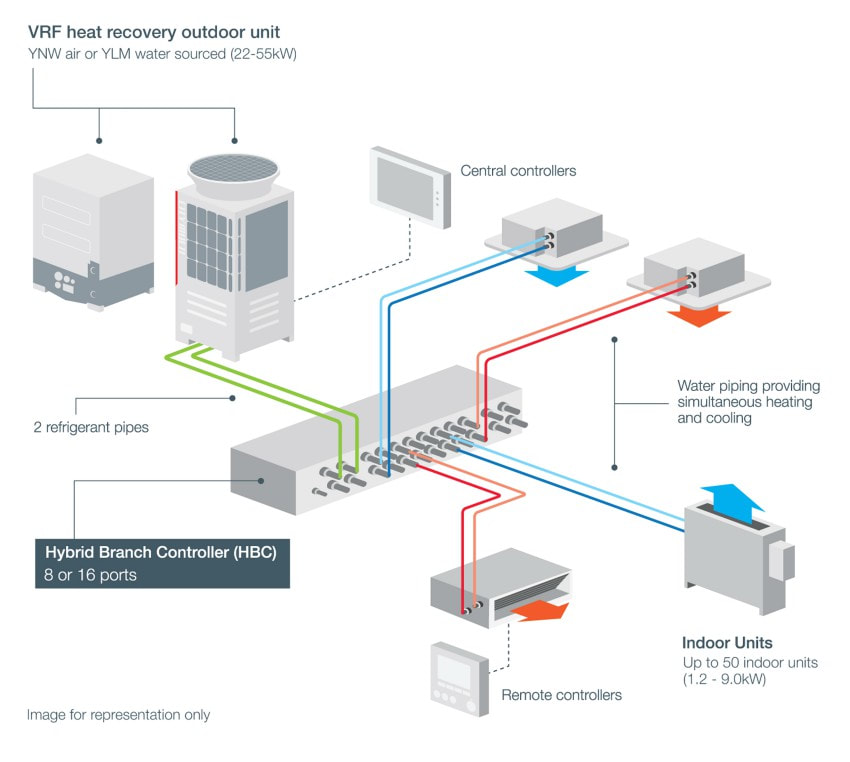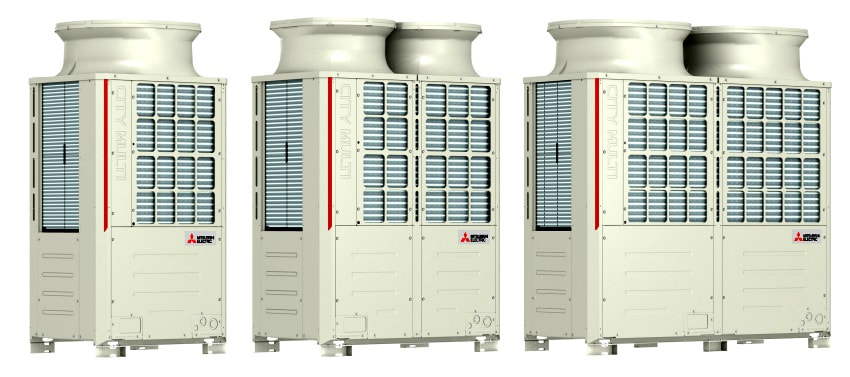08 August 2018
|
| Mitsubishi Electric expects the UK’s first R32 hybrid VRF system to be “a very big part of our future”. Mark Grayston, Product Marketing Manager for air conditioning systems, said the company regards the City Multi Hybrid VRF range as a key part of the move towards an electric economy. |
With the first units available from next month (September), Mitsubishi Electric says the R32 line-up offers all the benefits of VRF air conditioning in R32 format to deliver a system with a significantly lower global warming potential (GWP) than existing solutions.
Although sales of hybrid VRF experienced a relatively slow start, the company says confidence is now growing with the market doubling year on year and around 25% of UK VRF specifications now for hybrid systems. That figure is predicted to grow with the introduction of the R32 option.
Grayston said: “There have already been over 500 hybrid VRF systems installed across Europe since we launched five years ago and we believe this R32 version will increase the market share for this unique VRF solution. Not only can Hybrid VRF help remove the need for leak detection, this R32 version delivers the low GWP benefits that customers are now searching for.”
The UK accounts for around 50% of the European VRF market and existing VRF units use R410A which has a GWP of 2,088, while R32 has a GWP of 675.
Increased performance
Whilst a number of manufacturers have introduced R32 models in the room and packaged air conditioning range, Mitsubishi will now offer a UK model that provides a solution for large VRF systems.
“We already have split air conditioning models on R32 and have introduced hybrid VRF so that customers have a complete range of R32 solutions regardless of the building or situation,” adds Grayston.
“Coupled with this is the rapid price rises of R410A month by month which places a strain on traditional VRF systems so we want to ensure that both customers and installers not only have an alternative, but also get the added benefit of increased performance and advanced controls.”
Grayston used the example of R410A prixes rising from around £8/kg in March 2017 to around £00/kg in May 2017. In comparison, the price of R32 went from £8/kg to £15/kg in the same timeframe. That would mean additional costs for a typical VRF sytem of £1152 (R4120A) vs £96 (R32).
Mitsubishi Electric says hybrid VRF is suitable for almost any commercial building and has already been installed in offices, hotels, residential accommodation, showrooms, care homes and public houses, with the system delivering the design and installation flexibility of traditional VRF with comfort levels normally associated with 4-pipe fan coil systems.
Grayston said: “We’ve seen particular growth in hybrid VRF sales in both the office and hotel sectors and with this R32 version we have sought to answer one of the hottest topics in the UK air conditioning industry on how to tackle low GWP in larger systems. Hybrid VRF is also designed to offer customers a future-proof solution that delivers advanced efficiency with improved corporate social responsibility.
Maximum comfort
“Legislation is also now demanding that leak detection equipment is installed alongside VRF air conditioning when it is used in occupied spaces and this calls for additional equipment costs and added risk, as well higher maintenance bills. This new system does away with the need for leak detection whilst also delivering higher sensible cooling throughout the building.”
The hybrid solution uses water throughout the majority of the pipework to transfer simultaneous heating and cooling to different rooms yet still offers two-pipe heat recovery and lower annual maintenance costs.
The system features an HBC (Hybrid Branch Controller) box, which is connected to the outdoor unit via traditional refrigerant piping. Between the HBC box and the indoor fan coils, the system uses water piping but still offers high sensible cooling and stable room temperatures for maximum comfort. Mitsubishi Electric’s Jobin Varghese said the two-pipe heat recovery stuck to the basic principles of VRF and the design meant that everything was contained in one box, with all water components included. He said up to 50 indoor units could be connected to one outdoor unit and that systems typically required up to 30% less refrigerant volume than traditional VRF.
Mitsubishi Electric will support installers with free training and three days of site support. The first units available in September will be 20-30kW, expanded to 50kW next spring with a 50kW heat pump version also available.
Grayston said: “Beyond that we will continue to expand the range of both indoor and outdoor units. We see this as a very big part of our future.’’
More information is available here.
Although sales of hybrid VRF experienced a relatively slow start, the company says confidence is now growing with the market doubling year on year and around 25% of UK VRF specifications now for hybrid systems. That figure is predicted to grow with the introduction of the R32 option.
Grayston said: “There have already been over 500 hybrid VRF systems installed across Europe since we launched five years ago and we believe this R32 version will increase the market share for this unique VRF solution. Not only can Hybrid VRF help remove the need for leak detection, this R32 version delivers the low GWP benefits that customers are now searching for.”
The UK accounts for around 50% of the European VRF market and existing VRF units use R410A which has a GWP of 2,088, while R32 has a GWP of 675.
Increased performance
Whilst a number of manufacturers have introduced R32 models in the room and packaged air conditioning range, Mitsubishi will now offer a UK model that provides a solution for large VRF systems.
“We already have split air conditioning models on R32 and have introduced hybrid VRF so that customers have a complete range of R32 solutions regardless of the building or situation,” adds Grayston.
“Coupled with this is the rapid price rises of R410A month by month which places a strain on traditional VRF systems so we want to ensure that both customers and installers not only have an alternative, but also get the added benefit of increased performance and advanced controls.”
Grayston used the example of R410A prixes rising from around £8/kg in March 2017 to around £00/kg in May 2017. In comparison, the price of R32 went from £8/kg to £15/kg in the same timeframe. That would mean additional costs for a typical VRF sytem of £1152 (R4120A) vs £96 (R32).
Mitsubishi Electric says hybrid VRF is suitable for almost any commercial building and has already been installed in offices, hotels, residential accommodation, showrooms, care homes and public houses, with the system delivering the design and installation flexibility of traditional VRF with comfort levels normally associated with 4-pipe fan coil systems.
Grayston said: “We’ve seen particular growth in hybrid VRF sales in both the office and hotel sectors and with this R32 version we have sought to answer one of the hottest topics in the UK air conditioning industry on how to tackle low GWP in larger systems. Hybrid VRF is also designed to offer customers a future-proof solution that delivers advanced efficiency with improved corporate social responsibility.
Maximum comfort
“Legislation is also now demanding that leak detection equipment is installed alongside VRF air conditioning when it is used in occupied spaces and this calls for additional equipment costs and added risk, as well higher maintenance bills. This new system does away with the need for leak detection whilst also delivering higher sensible cooling throughout the building.”
The hybrid solution uses water throughout the majority of the pipework to transfer simultaneous heating and cooling to different rooms yet still offers two-pipe heat recovery and lower annual maintenance costs.
The system features an HBC (Hybrid Branch Controller) box, which is connected to the outdoor unit via traditional refrigerant piping. Between the HBC box and the indoor fan coils, the system uses water piping but still offers high sensible cooling and stable room temperatures for maximum comfort. Mitsubishi Electric’s Jobin Varghese said the two-pipe heat recovery stuck to the basic principles of VRF and the design meant that everything was contained in one box, with all water components included. He said up to 50 indoor units could be connected to one outdoor unit and that systems typically required up to 30% less refrigerant volume than traditional VRF.
Mitsubishi Electric will support installers with free training and three days of site support. The first units available in September will be 20-30kW, expanded to 50kW next spring with a 50kW heat pump version also available.
Grayston said: “Beyond that we will continue to expand the range of both indoor and outdoor units. We see this as a very big part of our future.’’
More information is available here.
Content continues after advertisements










